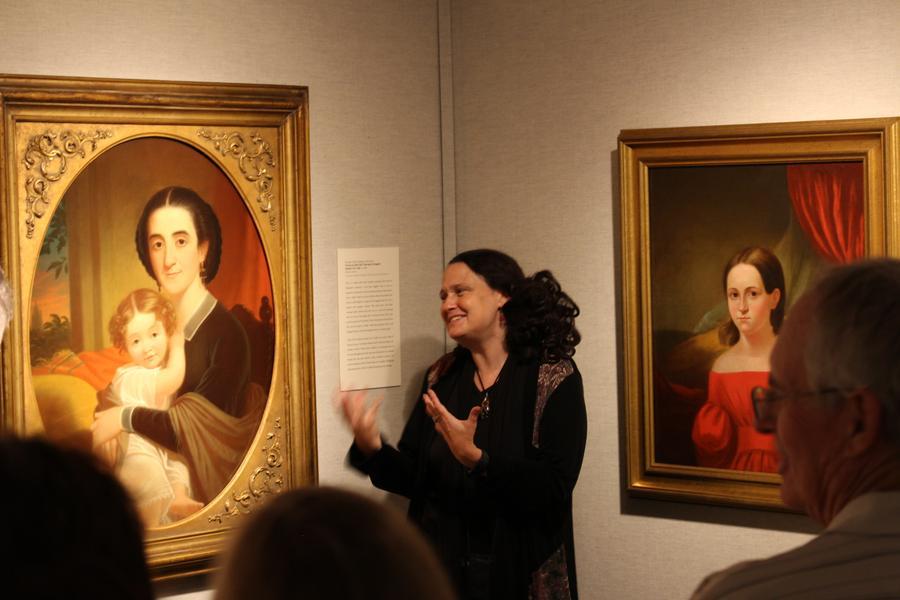
If I learned anything walking around the State Historical Society of Missouri’s current George Caleb Bingham exhibit and talking to Joan Stack, the curator of art collections, it was that things really have not changed that much.
“Old men still get crushes on girls and have to apologize to their wives,” Stack said, laughing as she pointed at a painting across the gallery.
In one of the last exhibits in the historical society’s current location in Ellis Library, the society is showing part of its Bingham portrait collection. This exhibit, Painted Personas, highlights a less-popular side of Bingham’s work.
Bingham is likely Missouri’s most famous painter. In the mid-1800s, Bingham created America’s most quintessential depictions of the Western frontier and the people inhabiting it. His genre paintings are some of America’s most well-known contributions to the Western world.
Stack helped organize the exhibit and gave a guided walkthrough of the gallery Aug. 26. She is a bit of a Bingham fanatic.
“I sometimes look up and say, ‘Well, that’s a Bingham sky,’” Stack said when talking about her personal connection to Bingham as a fellow lifelong Missourian. “We have beautiful skies here in Missouri.”
She began the walkthrough with an explanation that the exhibit’s layout was based on function rather than types of individuals. Bingham created each portrait with an intent for it to be displayed in a certain public or private place, like a bedroom or government building, so the historical society preserved his intent by organizing the portraits into their functions.
During her walkthrough of the centuries-old paintings, Stack’s excitement was infectious. Often referencing the “panache” of Bingham’s work, every portrait gained a bit of magical energy with each additional anecdote.
Going from painting to painting, Stack focused on the state of society Bingham was trying to portray, though sometimes her admiration for his technical skill would burst through.
“Just look at that shoulder!” Stack said, looking at an anatomically disproportionate portrait.
Bingham’s paintings also show how society changed during his lifetime. Women progressively show more hair, and political tensions are hinted at in a portrait of a Confederate leader.
The crowd at the walkthrough was noticeably aged. I was definitely the youngest person there, which was a shame considering Bingham’s relevance.
As the walkthrough winded down, Stack mentioned how modern controversies over Confederate monuments and iconography have made younger people more attentive to the images around them.
“Portraiture matters in the public sphere,” Stack said. “By studying the art, we learn who we are, who we were and where we are going.”
Despite the grandeur of a painter like Bingham and the exuberance of a fan like Stack, the historical society’s current location can seem underwhelming. Practical, efficient and modest, the main gallery is a dull gray. The ceilings are low.
“I love to go out on the river and see that kind of Bingham-esque quality to the atmosphere that he captures so well in his river paintings, like the one we have in our gallery,” Stack said. Yet the space that houses these beautiful Missouri vibes conveys nothing close to that mystical experience.
Maybe that is part of the reason younger people avoid these kinds of places, despite how relevant the lessons within can be.
“Missouri is in some ways a microcosm of the nation,” Stack said. “I think there are things about Missouri, because it’s a place where a lot of people from different places come together that make it an interesting, schizophrenic place. I think his imagery can sometimes tell us a lot of about the nation in 19th century and its relationship with its own diversity.”
Next year the historical society is moving to a new building with a sleek, modern construction that is closer to downtown. It is likely this new location will provide a greater setting to experience Bingham’s and more of the the historical society’s collection. Stack seemed particularly excited about the taller ceilings.
As the historical society’s current location awaits its farewell, its future reincarnation will hopefully mirror a more willful social shift back to the arts.
“No matter your politics, it’s good news when people care about art,” Stack said.
_Edited by Claire Colby | [email protected]_